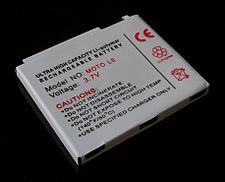Lithium ion polymer battery

A lithium-ion polymer battery used to power a mobile phone
|
|
| Specific energy | 100–265 W·h/kg(0.36–0.95 MJ/kg) |
|---|---|
| Energy density | 250–730 W·h/L(0.90–2.63 MJ/L) |
A lithium polymer battery, or more correctly lithium-ion polymer battery (abbreviated variously as LiPo, LIP, Li-poly and others), is a rechargeable battery of lithium-ion technology using a polymer electrolyte instead of the more common liquid electrolyte. High conductivity semisolid (gel) polymers form the electrolyte for LiPo cells that are being used in tablet computers and many cellular telephone handsets.
LiPo cells follow the history of lithium-ion and lithium-metal cells which underwent extensive research during the 1980s, reaching a significant milestone with Sony's first commercial cylindrical Li-ion cell in 1991. After that, other packaging forms evolved, including the pouch format now also called "LiPo".
Lithium polymer cells have evolved from lithium-ion and lithium-metal batteries. The primary difference is that instead of using a liquid lithium-salt electrolyte (such as LiPF6) held in an organic solvent (such as EC/DMC/DEC), the battery uses a solid polymer electrolyte (SPE) such as poly(ethylene oxide) (PEO), poly(acrylonitrile) (PAN), poly(methyl methacrylate) (PMMA) or poly(vinylidene fluoride) (PVdF).
...
Wikipedia
